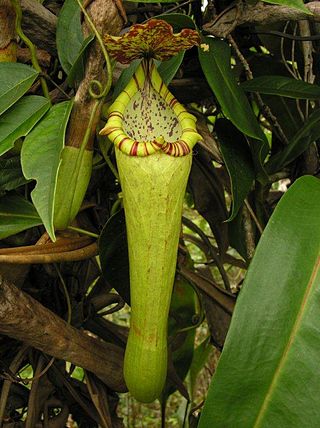博世猪笼草
来自维基百科,自由的百科全书
博世猪笼草(学名:Nepenthes boschiana),又称包希猪笼草[3],是婆罗洲南加里曼丹省特有的热带食虫植物。[3]其种加词来源于约翰内斯·范登博世的名字。它与法萨猪笼草(N. faizaliana)之间存在着密切的近缘关系。尚未发现博世猪笼草的自然杂交种。[4]也未有关于博世猪笼草变型或变种的描述。[2]博世猪笼草被归入“大猪笼草系”中,其中还包括陈氏猪笼草(N. chaniana)、附生猪笼草(N. epiphytica)、艾玛猪笼草(N. eymae)、法萨猪笼草、暗色猪笼草(N. fusca)、克洛斯猪笼草(N. klossii)、大猪笼草(N. maxima)、宽唇猪笼草(N. platychila)、窄叶猪笼草(N. stenophylla)和佛氏猪笼草(N. vogelii)。[5]
| 博世猪笼草 | |
|---|---|

| |
| 博世猪笼草的上位笼 | |
| 科学分类 | |
| 界: | 植物界 Plantae |
| 演化支: | 维管植物 Tracheophyta |
| 演化支: | 被子植物 Angiosperms |
| 演化支: | 真双子叶植物 Eudicots |
| 目: | 石竹目 Caryophyllales |
| 科: | 猪笼草科 Nepenthaceae |
| 属: | 猪笼草属 Nepenthes |
| 种: | 博世猪笼草 N. boschiana
|
| 二名法 | |
| Nepenthes boschiana | |

| |
| 博世猪笼草的分布范围 | |
| 异名 | |
| |
植物学史

彼得·威廉·科萨尔在其1839年发表的专著《关于猪笼草属》中正式描述了博世猪笼草。[1]B·H·丹瑟在其1928年发表的专著《荷属东印度群岛的猪笼草科植物》中写道:[注 1][6][7]
| “ | 科塔尔斯提到,陪同他的当地人会采集未打开的捕虫笼,捕虫笼里的液体是当地治疗眼部炎症的药物。同时,还会采集打开了的捕虫笼作为孩子们的玩具。科塔尔斯描述其原生地为贫瘠、开阔且多石的。当地人将其称为‘daoen sompitan’,翻译过来即是‘巨型的管道状叶片’。 | ” |
种下类群
- Nepenthes boschiana var. lowii Hook.f. (1873)[8][=N. stenophylla]
- Nepenthes boschiana var. sumatrana Miq. (1858) [=N. sumatrana]
注释
参考文献
扩展阅读
Wikiwand - on
Seamless Wikipedia browsing. On steroids.

